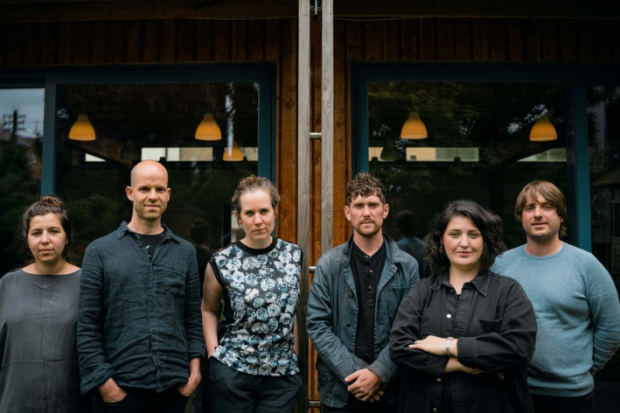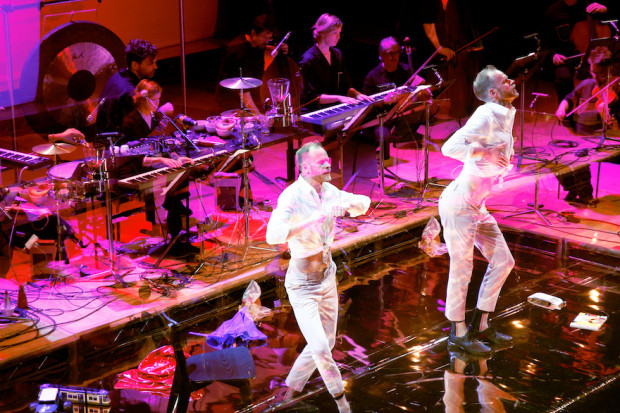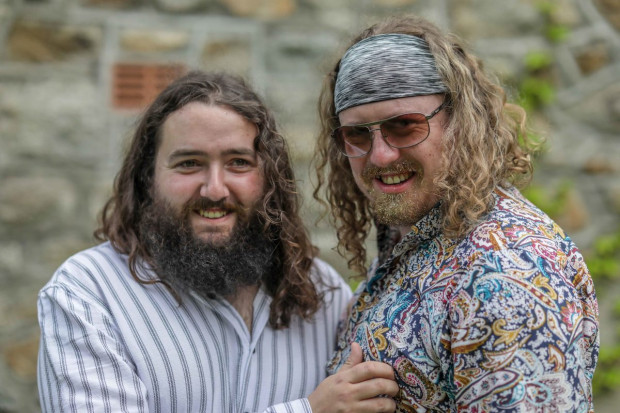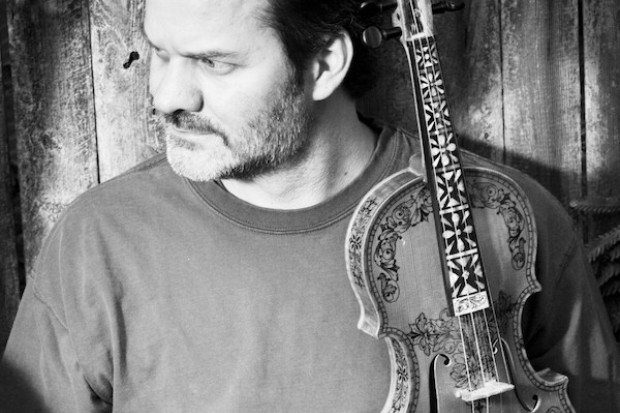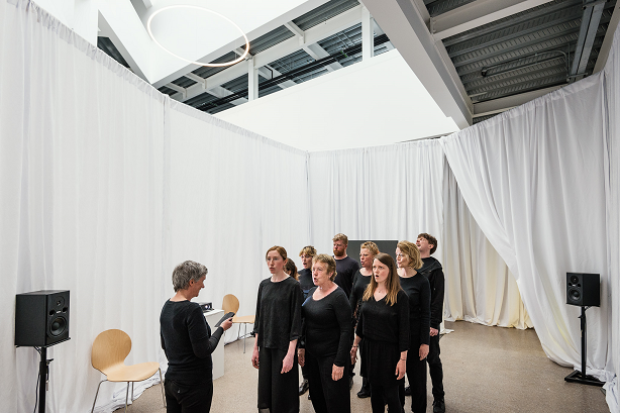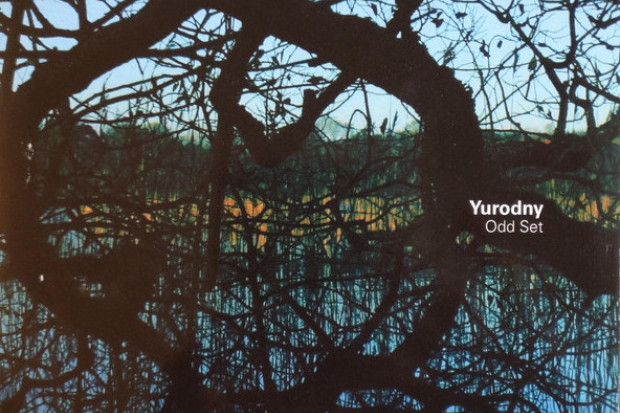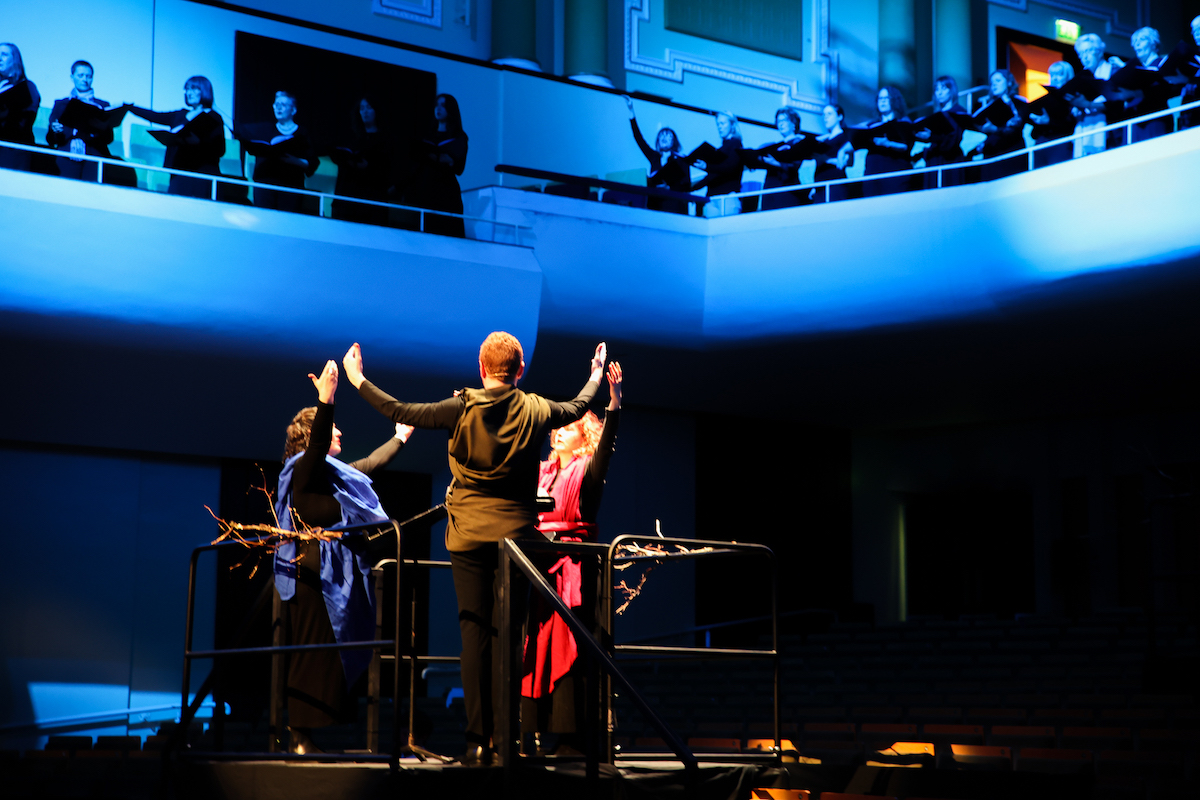
Michelle O’Rourke, Eoghan Desmond and Frauke Aulbert in Ann Cleare's 'MIDHE' (Photo: Molly Keane)
Marking a Decade Exploring the New Music Scene
The annual New Music Dublin festival returned for its tenth year last weekend (20–23 April), with almost thirty concerts. It also included a raft of nineteen world premieres, including major new works by Donnacha Dennehy, Ann Cleare, Kevin Volans and Karen Power, as well as two full orchestra concerts and a visit from the great Ensemble Modern. Last year’s festival, which included such amazing and exuberant concerts as Colm O’Hara’s 10tet and Jennifer Walshe’s PERSONHOOD, was one of my favourite iterations of the event, so I had been counting down the days to this year’s instalment of Ireland’s flagship contemporary classical music festival ever since.
Ambitious: Crane’s Natural World
There was no official theme to New Music Dublin 2023: director John Harris seems to prefer to present it as an expansive, inclusive snapshot of what’s happening in the new music scene. Nevertheless, certain strands of modern music were particularly well-represented this year. One of these was Feldmanian or ambient minimalism.
The first of the concerts in this tradition was Laurence Crane’s hour-long new work Natural World (2021), performed on Friday by Juliet Fraser (voice) and Mark Knoop (piano), whose recording of the work was released on the Another Timbre label the previous week. This piece started off in familiar territory for Crane: simple, diatonic-seeming figurations softly and ever so slowly juxtaposed with one another to no clear structural end, but with familiar tonalities placed so insistently outside their familiar contexts that the ear gradually loses the sense that they are treated unusually, and instead comes to accept the uncanny logic with which the music treats them. Fraser enters after about ten minutes, intoning isolated words and phrases (‘molluscs’, ‘cliffs’, ‘approximately fifteen centimetres long’, etc.) that are as disconnected from regular syntax as Crane’s triads are from traditional tonality. Taped birdsong also enters. About halfway through, there is an extended moment where birdsong is all we hear; when the musicians re-enter, the soundworld is richer and even more ethereal, with both musicians now playing synths as well: Fraser on a Casio keyboard, and Knoop on a tiny synth organ. The musical and lyrical fragments are occasionally woven together now, too; there are even a few recognisable stanzas supported by functional harmony. Eventually, we are left with just the organ and Fraser’s echoing of ‘Strange place of beauty / The edge of the sea’ fading into silence.
As with all of Crane’s music, Natural World demands openness and patience from its listeners, but it is more ambitious than his previous work and the new ground he breaks in his style is engaging without compromising the purity of his soundworld. Fraser and Knoop are superb exponents: Fraser’s clear voice and straight tone, in particular, mirror the simplicity and transparency of Crane’s music perfectly, and both musicians have a wonderful ability to sustain his glacial musical movements.

Juliet Fraser performing Laurence Crane’s Natural World (Photo: Molly Keane)
Coming from nowhere: Robert Curgenven’s ‘All that Is Solid Melts into…’
Knoop’s miniature organ was answered late on Saturday evening by the pipe organ of Mercy International Centre on Baggot Street in another ambient concert, of new works composed and performed by Robert Curgenven. Alongside premieres of Unstable Steady States (A/B/C) and two arias from Open Form Pavilion of Air, a site-specific (Merrion Square) app-based festival commission, he also played from his Tailte Cré-Umha (2021). Curgenven requested no applause between the works, and combined with the programme’s sharp musical focus, it created something coherent enough to merit the title it was given, ‘All that Is Solid Melts into…’ The title was especially apposite in the Mercy: Curgenven was mostly invisible behind the organ manual on the balcony and the instrument and electronics filled the space evenly, so the impression was that the music, as still as the air, was coming to us from nowhere, as if the air itself spontaneously erupted in sonorous vibration. Curgenven’s minimal style, in which crucial noises are on the cusp of hearing and in which the interesting musical material is the physical beat of close harmonies or the way deep notes are felt rather than heard, encourages close attention to this physical aspect of sound. (His programme notes offer rewarding further reflection on this.)
Ambiguous, compelling: Quiet Music Ensemble
The Cork-based Quiet Music Ensemble opened Sunday’s proceedings with the festival’s third concert of slow, delicate minimalism. Kathy Hinde’s Acts of Balancing and Unbalancing (2022), written for the ensemble as all the music in this programme was, was as much a kinetic sculpture as a musical work, having a centrepiece of two large scales of delicate wood from which hung vials of water and to which was attached a series of gear wheels. They were each hooked up to some electronics and a speaker, and the gentle music was controlled partly by the performers, but also by emergent reactions to the room.
Following this was Anna Murray’s Aioi: leaves laden with words (2022). The musicians improvised on the basis of a graphic score – a set of suiboku-ga ink wash paintings of Murray’s, each depicting the pine tree at the back of a traditional Noh stage – and were joined by Noh chanter Laura Sampson. The musicians were arrayed around the circumference of the stage like trees around a forest clearing, and created, along with some taped birdsong, an inviting bed of sound into which Sampson, kneeling in the centre, intoned, in Noh style, the encomium to the trees of Ireland in the tale of Buile Suibhne. The affect of the piece – particularly regarding Suibhne’s madness – was delicately ambiguous, and entirely compelling.
After a short interval, we heard the premiere of Susan Geaney’s Hahnemühle. For this piece, the performers manipulated artist paper from the iconic manufacturer Hahnemühle. Three performers sat around a central table with microphones at its centre and manipulated the paper with their hands and various other objects such as a chalk duster and paintbrush, and Ilse De Ziah and Dan Bodwell used their instruments. The work was hugely restrained. Unlike other works including paper manipulation, there was never an act as violent as tearing. The musical interest lay in how subtly different papers respond differentially to soft manipulation. I wish I had known to listen out for this: the programme note had no information about the piece (what I say here comes from Quiet Music Ensemble’s Twitter). So I don’t know whether I missed the essence of the piece, or whether (as I suspect) the recording set-up was not sensitive enough to pick up the extremely subtle distinctions that were Geaney’s musical interest. Perhaps I ought to give myself a home performance of this piece.
Finally, we heard …we return to ground… (2022) by Karen Power, dancer Mary Nunan and filmmaker Atoosa Pour Hosseini. It started with the ensemble agitating bowls of water containing hydrophones and a taped field recording of water environments in Ireland and Sweden. In a second section, the musicians turned to their instruments as a screen overhead displayed blank film that had been physically manipulated (e.g. through being drawn on or water-damaged), and Nunan trepidatiously took the stage. I was especially taken by Nunan’s dance, which slowly unfurled over the course of the work to take on a still-halting but curious mien.

Laura Sampson and Quiet Music Ensemble performing Anna Murray’s Aioi: leaves laden with words (Photo: Molly Keane)
Fresh inspiration: Crash Ensemble play Dennehy
Crash Ensemble were well-represented this year, with three substantial concerts in the festival. The first of these, on Thursday evening, consisted of the premiere of a new piano and ensemble work by Donnacha Dennehy along with two earlier solo pieces of his. Percussionist Alex Petcu performed Paddy (2003) with great drive and a full dynamic range, and brought a light ‘drunk’ swing to a very straight notation that made this twenty-year-old piece feel absolutely contemporary. Violinist Courtney Orlando then played Overstrung (2010), a piece played almost entirely on harmonics, with wonderful clarity and purity of tone.
The centrepiece, though, was Dennehy’s new piano chamber concerto, Limina, with Eliza McCarthy on piano. The work, in a conventional three-movement format, opened with a brittle but joyful descending motif played by McCarthy and taken up – fragmented, altered and transposed – by the ensemble. The movement gradually descends the register of the piano, which ends the movement with a fine cadenza. This is classic Dennehy: wearing his American minimalist influence with pride, but full of fresh inspiration and groove.
The second movement centred around a piano line that gestured at a traditional slow-movement air without ever giving us one, supported by a kaleidoscope of instrumental colours. Although conductor Ryan McAdams brought great pathos out of this movement, Dennehy seemed on less firm footing: his natural way of voicing chords – dry and bright – seemed to be at odds with the warmer voicings that the music seemed to want.
The final movement brought home some aspects to the work latent till then. It opened with a chordal groove on the piano on top of which the ensemble played like a progressive metal band. It suddenly sounded like we were hearing a concerto for chamber orchestra built upon the piano (which never let up once throughout the concerto) rather than a virtuoso showcase.
Limina is not a radical departure for Dennehy or a masterpiece, but it was consistently inventive, and an engaging and enjoyable listen.

Eliza McCarthy, Donnacha Dennehy, Ryan McAdams and Crash Ensemble (Photo: Molly Keane)
Vulnerable, transparent: ‘You Heard It First’
Crash’s second concert, on Friday afternoon, consisted of works by five young composers who have developed pieces for Crash in a series of workshops called ‘Crash Works’ over the last two years. This time last year, Crash performed earlier versions of these pieces; now we get to see how the pieces have grown a year later.
The first work, by Anselm McDonnell, was entitled Honnold after the record-breaking free solo climber Alex Honnold. Apart from a few moments (such as the clichéd use of the electric guitar), the work was well crafted and with a lot of nice ideas, but it seemed unconfident of itself, without a definite musical personality and with big sounds sometimes substituting for earnest feeling. Perhaps the problem here is of making the meaning or structuring principle of the work something profoundly extra-musical. I did not hear how the feats of Honnold supported the music, and (despite the attempts of McAdams and John Harris to present an interpretive path for the audience during set-up) I still do not know what it would be to hear this.
I find this an endemic problem in contemporary classical music, and similar problems affected other pieces in this programme. Úna Monaghan’s Little Auditoriums had a complex conceptual apparatus behind it, including wandering off-stage musicians, a musical representation of Google Ngram graphs, and a huge digital countdown timer on the stage. But I struggled to connect any of these things to the listening experience.
This same problem was in danger of afflicting Amy Rooney’s Disequilibrium: Rooney only has hearing in one ear and was interested in representing this musically. I don’t know if she succeeded in doing this – or how I would know if she had – but the complaint feels a bit academic regarding this piece because there was a great musical sense to the work. Disequilibrium was built around canons that hocketted across the stage creating a vibrant musical texture. There was also an excellent contrast of movement and rest, both at the micro-level of one of the main figures (a flurry of semiquavers followed by a sustained note) and the macro-level of the piece as a whole.
Yue Song’s Senses IV was trying something very different: a love letter to the senses, it comprised sounds that were replete with sensuousness and texture: chords you wanted to squeeze, melodic fragments you wanted to taste. Its sensuous polyphony of lovingly crafted semi-independent lines reminded me of Stravinsky’s wind writing. I only wish Song had had a bit more restraint: once or twice, the music seems to lose its nerve, becoming loud and dramatic in a way that is maybe a ‘safe’ way of keeping your audience awake, but when the writing is as good as Song’s is, it’s just not needed.
My favourite work of this programme was Laura Hyland’s Sleep Piece. Hyland, the leader of the excellent group Clang Syne, wrote this as a response to her experiences of lulling her infant daughter (also the work’s dedicatee) to sleep. It was mostly written away from the page, in workshop with Crash, and this is apparent in how unusual the piece is: it starts with Hyland on stage, back to back with the seated McAdams, breathing slowly, this breathing then taken up by the ensemble through their instruments. But to foreground these elements is perhaps a distraction. Sleep Piece was marked most of all by the love Hyland displayed for her daughter: every sound, from the slow ensemble chords to Máire Carroll’s tender piano cadenza that ended the piece, all seemed vulnerable, transparent, a gift.

Crash Ensemble performing Amy Rooney’s Disequilibrium (Photo: Molly Keane)
Warm, kind voice: Hamilton’s Friendly Piece
Crash also closed out the festival. Their final concert was the world premiere of Andrew Hamilton’s Friendly Piece. This piece started on the dot of 9:30pm, despite a late end to the previous concert meaning that the audience was still filing in, so I had to reorient myself when I realised that the friendly burbling coming from the stage was not the ensemble tuning but in fact the concert. This is not a criticism: Hamilton, in this work, has found a warm, kind, even humble voice that is almost self-effacing. Once we settled in, we were utterly charmed by the gentle wit of the work, full of musical winks and silly faces that were taken up and thematised by the ensemble. The audience’s delight was palpable. What Hamilton was burbling was mostly unintelligible but constantly suggested meaning, because it always ‘sounded like’ English, and also because every so often there would be a recognisable word or phrase. I wonder if this is what it’s like to be a baby strolled through the village in its pram, constantly approached by strangers cooing and smiling at you – a feeling of confusion and of concentration being asked of you, along with feeling safe and loved. Hamilton, who played like a continuo on voice and violin throughout the hour-long work, is to be credited here as composer and performer for concocting this rare delight, and Crash as an ensemble are also to be credited for finding endless sweetness in their instruments even while only occasionally relying on standard ingredients, such as major triads, to get there.
Friendly Piece grew beyond this, and even had a substantial, if tongue-in-cheek, climax. The piece lost some of its coherence with this, and would have been stronger if it had been more concise. But I will carry its friendly burbling in my heart as a revelation of what music can be.

Andrew Hamilton and Crash Ensemble following the premiere of Friendly Piece (Photo: Molly Keane)
A religious event?: Ann Cleare’s MIDHE
Friday and Sunday evenings were given over to orchestral music. The first of these headliners was given by the National Symphony Orchestra and National Symphony Chorus under David Brophy. It opened with the first tribute performance for Seóirse Bodley’s ninetieth birthday: his A Small White Cloud Drifts over Ireland (1975), performed with crispness and a great dynamic sense, though not always with a sure feeling for the Irish dance tunes. The majority of this concert, though, was given to two world premieres: by Amanda Feery and an enormous work by Ann Cleare.
Feery’s fifteen-minute My Year of Rest and Relaxation was a mature and refined work. A representation of insomnia and anchored by a recurring ticking-clock percussion, it was full of wonderful orchestral writing and inspired moments. It is a piece I would love to hear again, though, because it was a structurally complex piece that I do not feel I at all got inside.
The entire second half of the concert was given to Cleare’s massive MIDHE, in which the orchestra was joined by the NSC as well as soloists Frauke Aulbert (soprano), Michelle O’Rourke (mezzo-soprano), Eoghan Desmond (baritone) and Dermot Dunne (accordion). The piece caused a stir even as we filed in thanks to the theatrical promise of three imposing podiums, decorated lightly with tree branches, that had been placed in the stalls.
MIDHE is named after the erstwhile fifth province of Ireland, Midhe (or Mí), and which Cleare uses synecdochally to refer to the now-overlooked but historically often important middle of Ireland, as well as, by extension again, the ‘spiritual’ core of Ireland and the pre-Christian kingdoms and religions that had their centres of power and worship in Midhe. In Cleare’s own words, the purpose of MIDHE is ‘to recover, reclaim, and reanimate a lost centre.’
There is plenty of theatre in MIDHE: the four soloists are absent when the work begins, the three singers slowly drifting in from the sides and back of the auditorium and dressed in priestly robes, and Dunne hidden amidst the orchestra. The choir is spread out along the edge of the balcony like worshippers. Even the lighting is part of the work: during the long section when the four soloists perform alone, every light not on them is off – which means that the stage is in darkness, too, except for an embery spotlight on Dunne of whom we can see glimpses between the silhouettes of the orchestra members in front of him.
Musically, the work is consistently interesting and varied. Many passages are quiet and mysterious, built around slow glissandi and other non-tonal devices, but the music is also capable of the sort of unbridled emotion I associate with the high points of Bach Masses.
Indeed, I wonder whether MIDHE is supposed to be something more than theatre: a genuinely religious event. Perhaps those podiums in the centre of the auditorium are actually altars. If so, then what sort of event is MIDHE? At times, it feels like Cleare is writing the triumphal march for the imminent return of Ireland’s pre-Christian animism. But the music is rather too ethereal and equivocal for that. It seems to me more a summoning. Animism is portrayed as a ghost: dead, yes, but still powerful, if only by its power to represent an alternative to our own life, and a reminder of what died, not peacefully, to make way for that life.

The National Symphony Chorus in Ann Cleare’s MIDHE (Photo: Molly Keane)
Climate calling: Power, Dean and Volans
The second orchestral concert saw the RTÉ Concert Orchestra under Gavin Maloney perform Brett Dean’s Testament (2008) along with a premiere of Karen Power’s …Antarctica calling…listen… and a heavily revised version of Kevin Volans’ fourth piano concerto (‘Piano Concerto No. 4b’)
After Crane’s Natural World, Power’s …Antarctica calling…listen… was the second work of the festival to consider climate change, and it too does so by training its listeners’ attention on the nonhuman world as something strange, sublime and delicate. I am a fan of Power’s facility with field recordings, but I did not know that her orchestral writing was also consummate; the brass, in particular, of …Antarctica calling…listen… was astonishing in the depth of its icy colours. The music was supplemented by field recordings from Antarctica that Power collected in 2022 and photography, displayed large on a screen above the stage, taken by John Godfrey on the same expedition. These elements combined to create an immersive landscape of what Power calls ‘this ginormous and living environment, which can move from extreme stillness to deafening and ground-shaking cavings within seconds.’ Whether the work succeeded in directing us beyond itself to some particular attitude towards climate change is harder to gauge, but was certainly hampered by the inconsistent and distracting directing of Godfrey’s fine photography.
Volans’ 4b-th piano concerto is a substantial reworking of his fourth piano concerto from 2016: it is a third longer, the orchestra is larger, and the pianist (Isabelle O’Connell tonight) was joined by five MIDI pianos on a surround-sound tape part. Not for the first time in the festival, there were rumours and suspicions of electronic malfunctions, and this makes it hard to judge how successful Volans’ revisions were. With this caveat made, my impression was that the tape pianos added little more than colour, and that the cost of them, due presumably to the fact that the orchestra was now beholden to the (very audible) click track, was that there were several passages where the tempo did not have the rubato it needed for them to come to life. Combined with a trombone part that drowned out the rest of the orchestra, it made for a disappointing performance despite many brilliant moments.

Kevin Volans, Isabelle O’Connell and the RTÉ Concert Orchestra (Photo: Molly Keane)
Celebration and experimentation: Evlana ensemble
Surely the most wide-ranging, if also overly ambitious, programme of the festival was by the collective Evlana on Saturday. It opened with a fantastic rendition of George Crumb’s brilliant Apparition (1979). Sylvia O’Brien (soprano) and Isabelle O’Connell (piano) played this work with a great, delicate sense of drama and space. O’Brien and O’Connell also did justice to another Bodley work, Earlsfort Suite (1999–2000): O’Brien softened her voice for the three songs that comprise this work, making of them the intimate, internal ruminations of a passerby whom one happily imagines as a version of Leopold Bloom. The other large work of the programme was And the Movement of the Tongue (2012) by Pamela Z, which is notable for being the only work by a black composer in the festival. Evlana’s creative director Siobhán Cleary noted in a few introductory words that the themes of identity and language Z explores are also relevant in an Irish context.
The concert also saw a world premiere in Jenn Kirby’s Surrounding for William Dowdall’s flutes and electronics. This was perhaps the most experimental work of the festival, and alas the experiment did not particularly come off. Dowdall played with motion detectors attached to his hands that activated live electronics, but the audible result of this process was nothing more than familiar-sounding contemporary classical music. It seemed to me an odd choice to attach motion sensors to a flautist’s hands, which don’t move at all in the normal course of playing, but Kirby said that this was the start of an extended project with embodied music-making, so we will see where further experiments go.
In addition to these pieces were works that were neither new nor large-scale. Fergus Johnston’s Méadú (2001) at least returned a fiery and playful piece to concert rotation, but Solfa Carlile’s Dystopia (2010) and Missy Mazzoli’s A Thousand Tongues (2011) are miniatures that took almost as long to set up as to play. The concert ended up being two hours long without a break and it became a bit of a medley, weakening the impact of each piece.
Nimbleness and delicacy: Chamber Choir Ireland
Chamber Choir Ireland’s Saturday evening concert Poets, Passion and Peace, under guest director Sofi Jeannin, saw a world premiere of Áine Mallon’s Beloved in a tightly constructed programme that also brought several composers to my attention who are better known in Sweden and France than Ireland.
Mallon’s work, a setting of the second canticle of the Song of Songs, is a firmly traditional piece in its tonality, and shows great intelligence and sensitivity in how to write for voices, especially in her control of force and shade. It did also have a tendency to drift, though: the harmonic language moved across the centuries, and she seemed undecided what approach to take towards the setting. For example, the line ‘My beloved spoke and said to me:’ is sung by an alto, and the speech that follows by the tenors. This sets up a contrast in the setting that corresponds to that between narrator and speaker. But halfway through the quotation, Mallon sets it instead for the sopranos, undermining the matching of text and the setting previously set up. To do this sort of thing once or twice is fine, but the result of the accumulation of it is that the piece as a whole did not leave as strong an impression as many of its individual moments did.
Of other recent works in this programme, I was quite taken by Carl Unander-Scharin’s short ‘Mutations’, from his Calligrammes (2016–17), a suite of settings of Apollinaire’s poems. It was a brief invention that in its superficial ebullience captured the bitter humour of the French poet’s work.
I was hugely impressed by the standard of the choir throughout the recital. They form a well-balanced whole, able to create full and rich fortes that are still perfectly clear as well as sing with nimbleness and delicacy. I was also impressed by Jeannin’s musical judgement. For example, she programmed some Julien Joubert songs that could have been rather saccharine, but which, through her restraint, were instead sweet and light.
Flowers opening: Katie Gerardine O’Neill
New Music Dublin is not always the place to find the most esoteric improvised music around, so it was a pleasant surprise to hear Katie Gerardine O’Neill’s late-night set in support of Jürgen Simpson’s performance of Simeon ten Holt’s Canto Ostinato (which I sadly had to leave just as it was getting into its swing). O’Neill’s was a meandering, experimental set that was hard to see as a whole: the moments seemed all to live for themselves, strange distorted records of pompous nineteenth-century orchestral music scratched together against timelapse videos of flowers opening, at one point. But there was a disarming warmth to the sounds. I was utterly charmed by an extended passage of lovely pink noise contrasted with a video of analogue film artefacts that resembled Rothkos.

Katie Geraldine O’Neill (Photo: Molly Keane)
Pedagogical mission: Ensemble Modern, Cór na nÓg and Cór Linn
New Music Dublin exists primarily as a site of challenging music, but it has long had a secondary pedagogical mission. Saturday saw four events of concerts for families and children, led by such excellent Irish composers as Karen Power and Brian Irvine. Saturday also saw two performances under Mary Amond O’Brien. Cór Linn gave the Irish premiere, almost completely from memory, of the choral suite of Craig Hella Johnson’s Considering Matthew Shepard (2017), which also had many solos that the soloists sung finely. Cór na nÓg, also from memory, treated us to Elaine Agnew’s We Are What Gives Us Strength (2019).
The festival, in addition, saw the culmination of a tutoring programme between Ensemble Modern and students of the Royal Irish Academy of Music. They took the stage together, playing first Hans Zender’s Modelle für variable Besetzung (1971–73) and then David Fennessy’s Open Ground (2022). The performance was excellent, especially of the Zender, which has plenty of tricky moments. Finally, it was great to see that the festival hosted a workshop for choral composers on the Thursday morning.
New Music Dublin ‘23: over-familiar?
Some years ago, I complained about the pricing structure of New Music Dublin, and I was glad to see that things were more affordable this year: even the full-length orchestral concerts were a very fair €28 for the best seats in the house (if you got in early enough), and the RTÉ Concert Orchestra’s concert had €10 concession tickets.
Even as I lived and breathed New Music Dublin for four days, I only experienced part of it. There were more concerts (Andrew Zolinsky, Roger Doyle, Elizabeth Hilliard) and more premieres (Ailís Ní Ríain’s Refuse to be wrecked), not to mention film screenings and an art exhibition. I still, though, got a sense of which sides of contemporary music were especially well-represented – as well as which sides were under-represented. Ireland’s vibrant free jazz scene was absent as was any programming-level engagement with traditional music or EDM (electronic dance music), and apart from the almost ubiquitous lighting effects, only occasional and mostly incidental appearances were made by filmic and theatrical elements in the concerts. It is also a point of continued wonderment for me that contemporary classical music festivals feature almost nothing in the way of experimental hip hop, despite how radically this genre has upturned the foundations of music. It is not necessarily a criticism to point out these lacunae – I know for a fact that some of them are well excused, and no festival can represent the entire contemporary classical music landscape – but the accumulation of them perhaps explains why this year’s festival felt a touch over-familiar. This year’s festival was good. I would recommend any of its concerts and I would recommend it as a whole. But New Music Dublin is the main event on Ireland’s contemporary classical music calendar and I presume it aspires to be more than ‘recommendable’. As it enters its second decade, I would hope it could afford to be a bit more experimental, to extend its ambit a bit further.
Visit www.newmusicdublin.ie.
Published on 26 April 2023
James Camien McGuiggan studied music in Maynooth University and has a PhD in the philosophy of art from the University of Southampton. He is currently an independent scholar.










